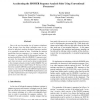Free Online Productivity Tools
i2Speak
i2Symbol
i2OCR
iTex2Img
iWeb2Print
iWeb2Shot
i2Type
iPdf2Split
iPdf2Merge
i2Bopomofo
i2Arabic
i2Style
i2Image
i2PDF
iLatex2Rtf
Sci2ools
AINA
2006
IEEE
2006
IEEE
Accelerating the HMMER Sequence Analysis Suite Using Conventional Processors
Due to the ever-increasing size of sequence databases it has become clear that faster techniques must be employed to effectively perform biological sequence analysis in a reasonable amount of time. Exploiting the inherent parallelism between sequences is a common strategy. In this paper we enhance both the fine-grained and coursegrained parallelism within the HMMER [2] sequence analysis suite. Our strategies are complementary to one another and, where necessary, can be used as drop-in replacements to the strategies already provided within HMMER. We use conventional processors (Intel Pentium IV Xeon) as well as the freely available MPICH parallel programming environment [1]. Our results show that the MPICH implementation greatly outperforms the PVM HMMER implementation, and our SSE2 implementation also lends greater computational power at no cost to the user.
AINA 2006 | Biological Sequence Analysis | Computer Networks | PVM HMMER Implementation | Sequence Analysis |
| Added | 10 Jun 2010 |
| Updated | 10 Jun 2010 |
| Type | Conference |
| Year | 2006 |
| Where | AINA |
| Authors | John Paul Walters, Bashar Qudah, Vipin Chaudhary |
Comments (0)

